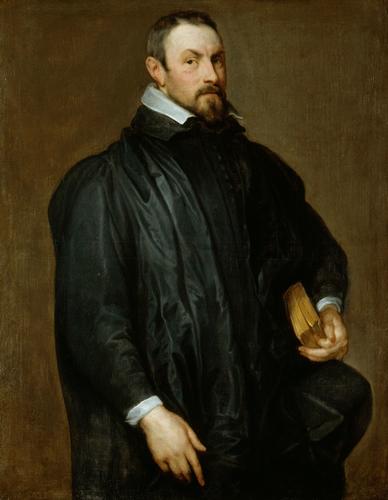Zeger van Hontsum (d. 1643) c. 1630
Oil on canvas | 108.0 x 84.2 cm (support, canvas/panel/stretcher external) | RCIN 405323
-
This portrait of a canon of Antwerp Cathedral, clutching his biretta and Prayer Book, dates from the years (1627-33) that Van Dyck spent in Antwerp, between his Italian and English trips. It was painted at one of the most exciting moments in the history of portrait painting, when Rubens and Frans Hals (c.1580-1666) were at the height of their powers and when Velázquez (1599-1660) and Rembrandt (1609-69) were launching their careers.
Part of Titian’s appeal to Van Dyck and his contemporaries lay in the richness of his effects, seen emulated in the brilliant colour and silky textures of the Mystic Marriage of St Catherine (Royal Collection). There is however another, more economical side to Titian’s art, seen particularly in certain of his portraits. In these cases he appears to use his canvas and colour rather like the paper and chalks of a draughtsman, laying in as few colours as possible - just enough of them to realise a figure and no more. This effect appealed (in different ways) to every one of the portrait painters listed above and is what Van Dyck seeks here.
The most popular form of drawing at this time was executed in black, white and red chalks on grey paper. The background here is a light blue-grey, with no particular reference to any architectural surface, just like the untouched paper of a drawing. The figure is executed entirely in black, with white added to achieve the one effect of richness - the snaking highlights of the silk ecclesiastical robe. The red is kept back as the single accent of colour for the small areas of exposed flesh on the face and hands. We seem to witness the moment at which a monochrome mould cracks open. The result also has the effect of a drawing, which we read always as ‘becoming’ what it depicts, rather than merely being incomplete. The way in which the figure here is surrounded by an unbroken fringe of shadow echoes the strong chalk outline of a drawing and creates an eye-catching éclat, like a cut-out. Identical effects are much commented upon in later works by Velázquez and Edouard Manet (1832-83).
Catalogue entry adapted from Bruegel to Rubens: Masters of Flemish Painting, London, 2007Provenance
Purchased by George III with the collection of Consul Smith in 1762 (Flemish and Dutch list no 13); recorded in the King's Closet at St James's Palace in 1786; moved to Buckingham Palace in 1809 and listed there in the King's Breakfast or 'Coffee' Room in 1819 (no 768); in the Picture Gallery at Buckingham Palace in 1841 (no 44)
-
Creator(s)
Acquirer(s)
-
Medium and techniques
Oil on canvas
Measurements
108.0 x 84.2 cm (support, canvas/panel/stretcher external)
128.4 x 105.0 x 7.0 cm (frame, external)
Other number(s)
Alternative title(s)
Zeger van Hontsum (d. 1643), Canon of the Cathedral at Antwerp








